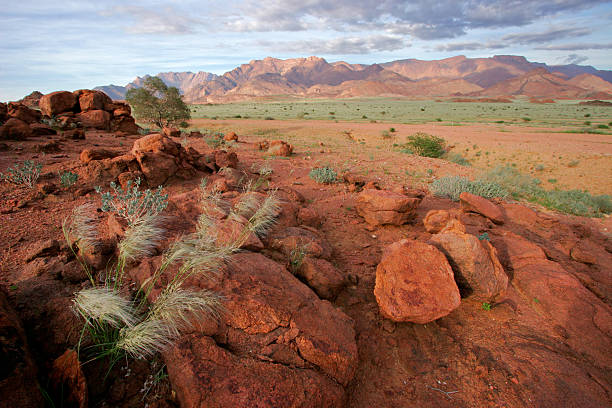The Brandberg’s Timeless Grandeur
Namibia, a land of stark desert landscapes and ethereal beauty, is home to one of its most iconic features—the Brandberg Mountains. These rugged peaks, piercing the African sky, have long captured the imagination of adventurers, geologists, and indigenous peoples. Rising prominently above the Namib Desert, the Brandberg Mountains stand as a testament to the captivating mysteries of nature. In this blog post, we embark on an exploration to decipher the secrets behind their prominence, from geological wonders to cultural significance.
 1. Geological Marvels: The Artistry of Nature
1. Geological Marvels: The Artistry of Nature
Crafting Masterpieces over Millennia
The Brandberg Mountains are a geological masterpiece, sculpted by the forces of nature over millions of years. To truly grasp their prominence, one must journey into the heart of their formation.
Tectonic plate movements, volcanic eruptions, and relentless erosion have all played a part in shaping these mountains. The result is a landscape adorned with breathtaking rock formations, deep canyons, and surreal petroglyphs that speak of the earth’s tumultuous past. Each layer of rock tells a story of time’s passage, and the Brandberg Mountains are a vivid canvas of these ancient tales.
2. Ancient Art and Petroglyphs: A Testament to Humanity’s Past
Guardians of Ancient Wisdom
The Brandberg Mountains are not just geological marvels; they are also repositories of human history. The mountains are adorned with thousands of petroglyphs and rock paintings, created by indigenous San peoples over thousands of years.
These ancient artworks provide a window into the spiritual and cultural lives of the San, depicting scenes of daily life, rituals, and the mystical world of the spirit. They are a testament to the enduring connection between humans and nature, etched into the very heart of the Brandberg Mountains.
3. Biodiversity Oasis: An Unexpected Haven
Nurturing Life in Arid Lands
One might not expect the arid Namib Desert to be a haven for biodiversity, but the Brandberg Mountains defy expectations. Their cooler altitudes and occasional rainfall create unique microclimates that support a diverse range of plant and animal species.
The Brandberg is home to rare desert-adapted elephants, mountain zebras, and a wealth of endemic plant life. These mountains offer refuge to species that have adapted to survive in one of the harshest environments on Earth, making them an oasis of life in the desert.
4. Cultural Significance: Guardians of Namibian Heritage
The Brandberg’s Role in Indigenous Cultures
For Namibia’s indigenous Himba people, the Brandberg Mountains hold deep cultural significance. They are considered the dwelling place of ancestral spirits and are central to the Himba’s spiritual beliefs.
The mountains are also a place of pilgrimage for those seeking healing and guidance. Visitors to the Brandberg can witness the Himba’s traditional ceremonies and rituals, gaining insight into a way of life deeply connected to the land.
5. Awe-Inspiring Landscapes: A Playground for Adventurers
Exploring the Brandberg’s Wilderness
Modern-day adventurers are drawn to the Brandberg Mountains’ rugged wilderness. Trekking through their labyrinthine canyons, scaling their summits, and camping beneath the starlit Namibian sky are experiences that beckon those with a sense of adventure.
The mountains offer a stark contrast to the surrounding desert, with lush valleys, hidden waterholes, and ancient trees. Climbing to the summit of the Brandberg’s highest peak, the ominously named “White Lady,” provides breathtaking vistas and a profound sense of accomplishment.
6. Conclusion: The Timeless Prominence of Brandberg
Guardians of Namibia’s Mysteries
In conclusion, the prominence of the Brandberg Mountains is a multifaceted tapestry of geological wonders, ancient art, biodiversity, cultural significance, and adventure. They are not just mountains; they are keepers of the Earth’s history, humanity’s past, and the living heart of Namibia.
As long as they rise majestically above the Namib Desert, the Brandberg Mountains will continue to be a symbol of nature’s enduring beauty and humanity’s connection to the land. Their prominence is an invitation to all to explore, learn, and be humbled by the grandeur of the natural world.




